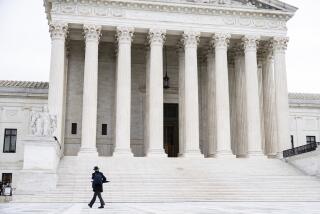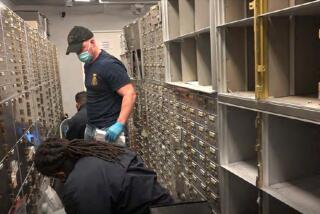Federal Court Gives Leg Chains the Boot
A federal appeals court on Tuesday overturned the U.S. Marshals Service’s policy of shackling defendants’ legs when they make their initial appearances in district court.
In a 2-1 decision, the U.S. 9th Circuit Court of Appeals said the marshals had not adequately explained why leg shackling was needed. However, the court said the policy could be reinstated if a justification based on past or present problems was presented.
The policy was enacted two years ago and approved by magistrate judges assigned to federal district courthouses in Los Angeles, Santa Ana and Riverside. The marshals cited safety concerns, aggravated by staffing cutbacks.
Following protests by the federal public defender’s office in 17 cases, the shackling issue was brought before U.S. District Judge Audrey B. Collins, who sided with the Marshals Service.
In a declaration submitted to the court, Robert Masaitas, chief deputy marshal for the Southern California region, said leg chains were necessary because it often is not possible to determine if a defendant is dangerous before he is brought before a magistrate judge.
Masaitas also revealed that the Marshals Service was operating at 59% of its authorized staffing level.
“There may well be good reasons for the policy but we don’t yet know what they are,” Chief Circuit Judge Mary M. Schroeder wrote in an opinion joined by Judge Ronald M. Gould.
“We order the existing shackling policy rescinded, but we do not preclude reinstatement of a similar policy upon a showing of adequate justification,” Schroeder said. Such a showing must be based on concrete experiences and circumstances, she added.
Schroeder quoted from a U.S. Supreme Court ruling that the use of shackles and restraints “is something of an affront to the very dignity and decorum of judicial proceedings that the judge is seeking to uphold.”
The appeals court sent the case back to Collins in Los Angeles for further hearings.
In a dissent, Judge Richard Clifton argued that prisoners were not prejudiced by being shackled during initial appearances because no jury was present.
By contrast, he noted that the Los Angeles County Superior Court keeps prisoners in cages during their initial court appearances.
At the Los Angeles federal court, prisoners arrive from jail in handcuffs and leg chains and are seated behind a plexiglass barrier. When their names are called by the judge, the marshals remove their handcuffs but not their shackles and escort them to a lectern for the proceedings. Afterward, the handcuffs are replaced.
Clifton cited the slaying of a federal judge’s husband and mother by a civil litigant in Chicago last year as well as the slaying of a judge and court reporter by a criminal defendant at the Fulton County Courthouse in Georgia as good reasons for the shackling.
“At a time when concern for security is understandably and properly high, I would accept the judgment of the district court -- and the collective judgments of the judicial officers most affected, the magistrate judges of the Central District,” he wrote.
Carlton Gunn, who argued the case on behalf of the public defender’s office, said his colleagues intend to press for an immediate lifting of the shackling rule.
More to Read
Sign up for Essential California
The most important California stories and recommendations in your inbox every morning.
You may occasionally receive promotional content from the Los Angeles Times.










